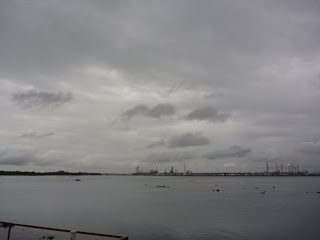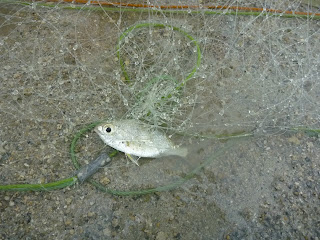We were back at Pulau Semakau on 4 Apr, for a guided walk with the students from Tampines Sec. Upon reaching the island, the looming dark skies spells of bad weather.
The perfect timing saw us seeking shelter at the entrance of the secondary forest - just as we reached the entrance point after the walk from the Visitors' Centre, the rain started pouring! Our hunter-seekers were already ahead of us, and I wondered if they too were seeking shelter in the forests.
After almost an hour, the rain though subside, continues to fall. The students, however, were not daunted a single bit and were really eager to start the walk.
With the absence of thunder and lightning, we braved the rain with our ponchos, for an hour of marine adventure.
Unfortunately, the first sight that greeted us was a drift net placed by irresponsible people. It had caught several fishes that were already dead. Drift net fishing not only results in unsustanable fishing, it also causes unnecessary harm to other marine animals that fishermen do not intend to catch. I shared the intention of Project Semakau with the participants, who concurred with the idea of gazetting the shore of Pulau Semakau as a protected area.
We visited the resident Anemone by the edge of the seagrass lagoon. Unfortunately, we didnt see the Anemone shrimp taking shelter under its usual host. The Anemone may look harmless, its lashing tentacles have stinging cells that may cause pain and discomfort to the skin.
Trotting on, I was glad to see the usual suspects at the sandy shore. The Sand-sifting Sea Star (Archaster typicus) is a good burrower of the sand (thus its name) and has a water vascular system to bring nutrients and oxygen through its body, unlike the blood circulation system in human beings.
My heart almost sank when I saw the Hairy Crab (Pilumnus vespertilio) at one of the stations. The hunter-seekers had prewarned us that the showcase of a Hairy Crab at a station indicates the desperation of the unsung hero(ine)s. We couldnt ask for more, because animals were pretty much hiding after the downpour.
Named after its hairy appearance, this crab is slow in movement as compared to other crabs. To make up for the speed, its appearance allows it to camouflage really well both in water and on land.
Kudos to some keen eyes, the less common Heart Cockle (Corculum cardissa) was spotted! A bivalve, the Heart Cockle's 2 valves are separated by an opening that cuts through the middle. A victim to over-collection of its shell, it is often marketed as a token of love sometimes at a fairly cheap price, thus popular among couples.
A Ovum Cowrie (Cypraea ovum) was also seen moving along the surface. Another victim of over-collection, its shell was once used as a form of currency in the past. I wondered how that money system worked though, nonetheless glad its no longer the case else this snail would be extinct by now! The cowrie maintained its smooth and pretty shell by covering it with its own mantle, which protects the shell from any abrasion and scratches.
Not sure what the common name is, but the very uninnovative me calls it the Green Nudibranch (Ceratosoma sinuatum). Nudibranchs are named after the naked gills exposed at its back, which it uses to breathe. Interestingly, they are actually hermaphrodites, possessing both the male and female reproduction organs.
I was really happy to see the Cushion Star (Culcita novaeguineae) that is no longer as juvenile as a few months back. In its teenage months, this individual has clearly become rounder. This shape, coupled with a calcified body, makes it difficult for predator to prey on it. Hope that it will soon grow into a healthy adult!
Thanks to the hunter-seekers who braved the storm to find us a Knobbly Sea Star (Protoreaster nodosus), often the highlight of any guided walk. This species of Sea Star, named after the knobs on its body, is endangered on our shores and has fallen victim to the aquarium trade. I once saw one in a store at Plaza Sing, clearly looking undernourished. Human beings is one 'predator' that the calcified Knobbly cannot run away from.
The Fan Worm (Sabellastarte indica) was one of the few who gamely displayed its beauty on this rainy morning. Its feathery tentacles opened broadly, looking just like a fan and was probably lashing through the water for very tiny food particles. The tentacles is often the only part of the fan worm that is exposed as it lives in a self-made tube of its own mucus, sand and particles. Any detection of danger results in the tentacles retracting into the tube at lightning speed, which often wowed the participants.
Despite the bad weather, we still managed to experience the life of our shores. The participants' spirits were not dampened, instead are more willed to visit our shores again for more exciting encounters.














No comments:
Post a Comment